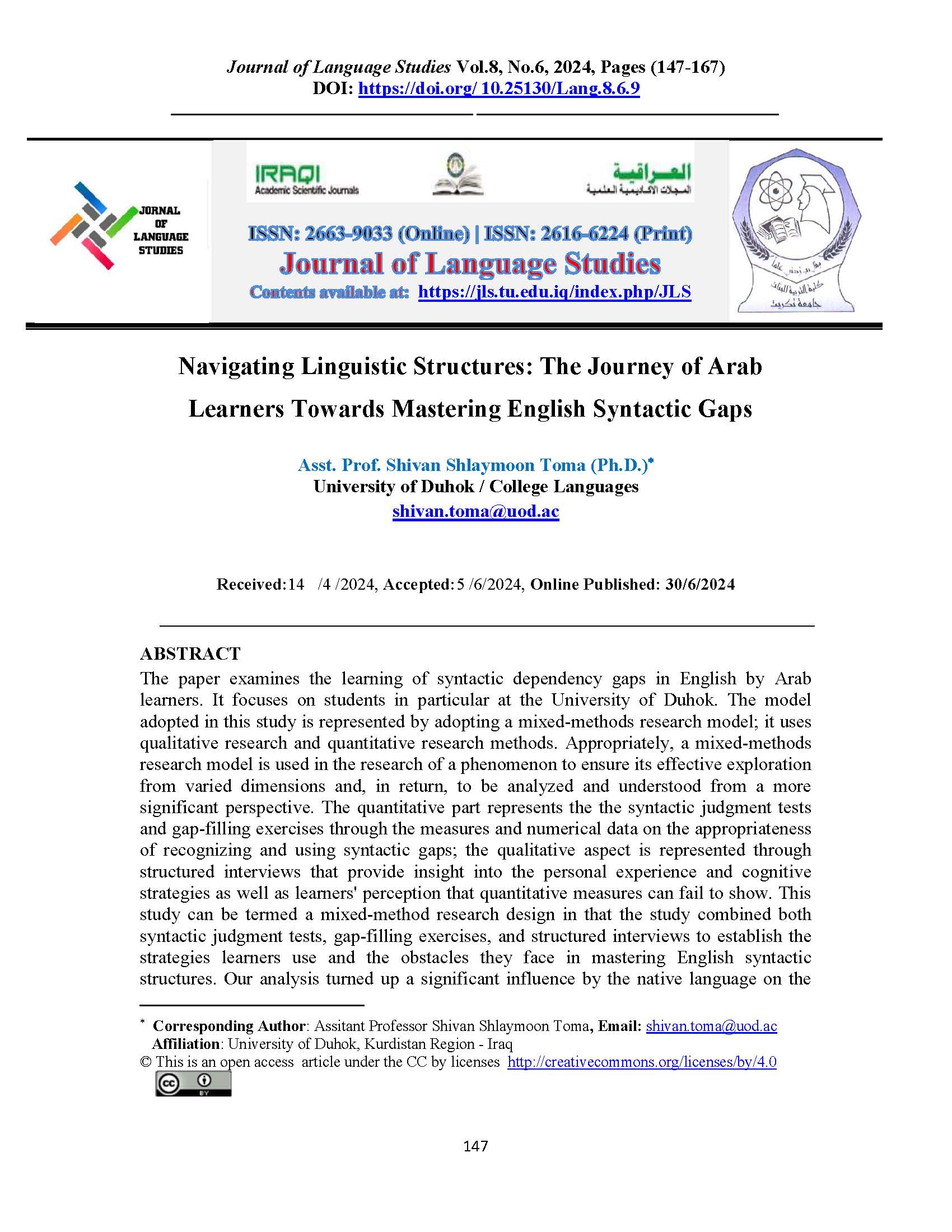Navigating Linguistic Structures: The Journey of Arab Learners Towards Mastering English Syntactic GapsNavigating Linguistic Structures: The Journey of Arab Learners Towards Mastering English Syntactic Gaps
Shivan Shlaymoon Toma
University of Duhok / College Languages
DOI: https://doi.org/10.25130/Lang.8.6.9
Keywords: Arab Learners, English Syntax, Syntactic Dependency Gaps, Second Language Acquisition, Language Teaching Strategies
Abstract
The paper examines the learning of syntactic dependency gaps in English by Arab learners. It focuses on students in particular at the University of Duhok. The model adopted in this study is represented by adopting a mixed-methods research model; it uses qualitative research and quantitative research methods. Appropriately, a mixed-methods research model is used in the research of a phenomenon to ensure its effective exploration from varied dimensions and, in return, to be analyzed and understood from a more significant perspective. The quantitative part represents the the syntactic judgment tests and gap-filling exercises through the measures and numerical data on the appropriateness of recognizing and using syntactic gaps; the qualitative aspect is represented through structured interviews that provide insight into the personal experience and cognitive strategies as well as learners' perception that quantitative measures can fail to show. This study can be termed a mixed-method research design in that the study combined both syntactic judgment tests, gap-filling exercises, and structured interviews to establish the strategies learners use and the obstacles they face in mastering English syntactic structures. Our analysis turned up a significant influence by the native language on the capability of the learners to recognize and use gaps in English syntax. We also found that this capability is impacted by proficiency levels. The study provides plenty of evidence for the utmost significance of tailored teaching techniques, based on the specific linguistic backgrounds of Arab learners, through the interconnection of both quantitative data from the tests and qualitative insights from the interviews. This does not only add to the general conversation on L2 acquisition but also gives more concrete pedagogical insights on the importance of improvement in proficiency level and individualized instructional intervention in growing into the acquisition of the syntactic gap for Arab learners of English.
References
Aoun, J., Benmamoun, E., & Choueiri, L. (2010). The Syntax of Arabic. Cambridge University Press.
Chomsky, N. (1981). Lectures on Government and Binding. Foris Publications.
Ellis, R. (2003). Task-based Language Learning and Teaching. Oxford University Press.
Gass, S. M., & Selinker, L. (2008). Second Language Acquisition: An Introductory Course. Routledge.
Krashen, S. (1982). Principles and Practice in Second Language Acquisition. Pergamon Press.
Lado, R. (1957). Linguistics Across Cultures: Applied Linguistics for Language Teachers. University of Michigan Press.
Ouhalla, J. (1991). Functional Categories and Parametric Variation. Routledge.
Selinker, L. (1972). Interlanguage. IRAL - International Review of Applied Linguistics in Language Teaching, 10(1-4).
Sells, P. (1984). Syntax and Semantics of Resumptive Pronouns. University of Massachusetts Amherst.

